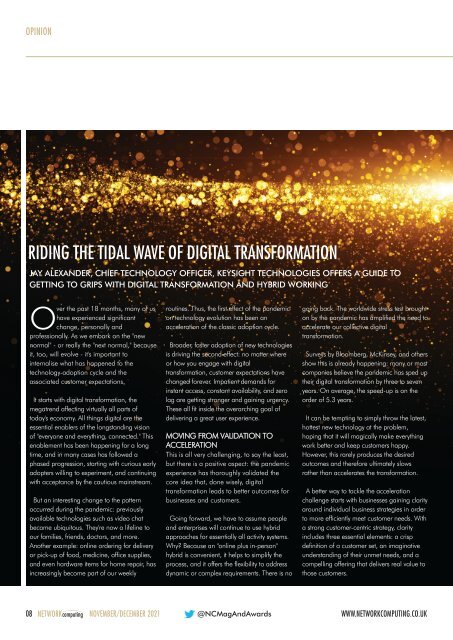NC Nov-Dec 2021
You also want an ePaper? Increase the reach of your titles
YUMPU automatically turns print PDFs into web optimized ePapers that Google loves.
OPINION<br />
RIDING THE TIDAL WAVE OF DIGITAL TRANSFORMATION<br />
JAY ALEXANDER, CHIEF TECHNOLOGY OFFICER, KEYSIGHT TECHNOLOGIES OFFERS A GUIDE TO<br />
GETTING TO GRIPS WITH DIGITAL TRANSFORMATION AND HYBRID WORKING<br />
Over the past 18 months, many of us<br />
have experienced significant<br />
change, personally and<br />
professionally. As we embark on the "new<br />
normal" - or really the "next normal," because<br />
it, too, will evolve - it's important to<br />
internalise what has happened to the<br />
technology-adoption cycle and the<br />
associated customer expectations.<br />
It starts with digital transformation, the<br />
megatrend affecting virtually all parts of<br />
today's economy. All things digital are the<br />
essential enablers of the longstanding vision<br />
of "everyone and everything, connected." This<br />
enablement has been happening for a long<br />
time, and in many cases has followed a<br />
phased progression, starting with curious early<br />
adopters willing to experiment, and continuing<br />
with acceptance by the cautious mainstream.<br />
But an interesting change to the pattern<br />
occurred during the pandemic: previously<br />
available technologies such as video chat<br />
became ubiquitous. They're now a lifeline to<br />
our families, friends, doctors, and more.<br />
Another example: online ordering for delivery<br />
or pick-up of food, medicine, office supplies,<br />
and even hardware items for home repair, has<br />
increasingly become part of our weekly<br />
routines. Thus, the first effect of the pandemic<br />
on technology evolution has been an<br />
acceleration of the classic adoption cycle.<br />
Broader, faster adoption of new technologies<br />
is driving the second effect: no matter where<br />
or how you engage with digital<br />
transformation, customer expectations have<br />
changed forever. Impatient demands for<br />
instant access, constant availability, and zero<br />
lag are getting stronger and gaining urgency.<br />
These all fit inside the overarching goal of<br />
delivering a great user experience.<br />
MOVING FROM VALIDATION TO<br />
ACCELERATION<br />
This is all very challenging, to say the least,<br />
but there is a positive aspect: the pandemic<br />
experience has thoroughly validated the<br />
core idea that, done wisely, digital<br />
transformation leads to better outcomes for<br />
businesses and customers.<br />
Going forward, we have to assume people<br />
and enterprises will continue to use hybrid<br />
approaches for essentially all activity systems.<br />
Why? Because an "online plus in-person"<br />
hybrid is convenient, it helps to simplify the<br />
process, and it offers the flexibility to address<br />
dynamic or complex requirements. There is no<br />
going back. The worldwide stress test brought<br />
on by the pandemic has amplified the need to<br />
accelerate our collective digital<br />
transformation.<br />
Surveys by Bloomberg, McKinsey, and others<br />
show this is already happening: many or most<br />
companies believe the pandemic has sped up<br />
their digital transformation by three to seven<br />
years. On average, the speed-up is on the<br />
order of 5.3 years.<br />
It can be tempting to simply throw the latest,<br />
hottest new technology at the problem,<br />
hoping that it will magically make everything<br />
work better and keep customers happy.<br />
However, this rarely produces the desired<br />
outcomes and therefore ultimately slows<br />
rather than accelerates the transformation.<br />
A better way to tackle the acceleration<br />
challenge starts with businesses gaining clarity<br />
around individual business strategies in order<br />
to more efficiently meet customer needs. With<br />
a strong customer-centric strategy, clarity<br />
includes three essential elements: a crisp<br />
definition of a customer set, an imaginative<br />
understanding of their unmet needs, and a<br />
compelling offering that delivers real value to<br />
those customers.<br />
08 NETWORKcomputing NOVEMBER/DECEMBER <strong>2021</strong> @<strong>NC</strong>MagAndAwards<br />
WWW.NETWORKCOMPUTING.CO.UK

















